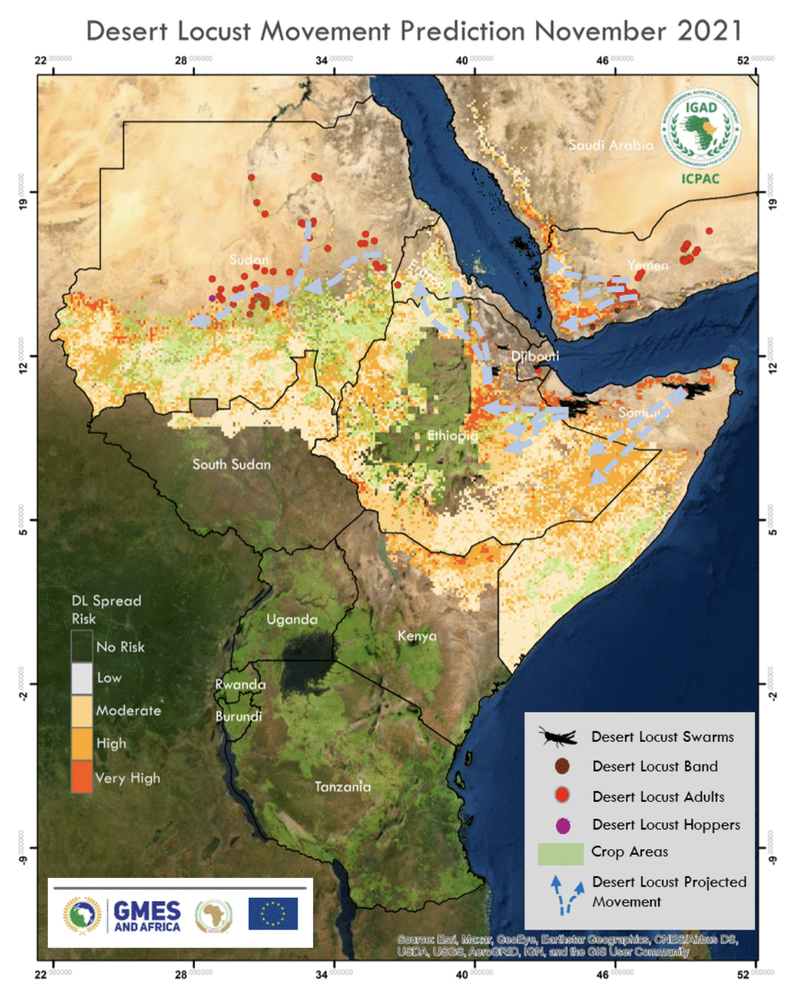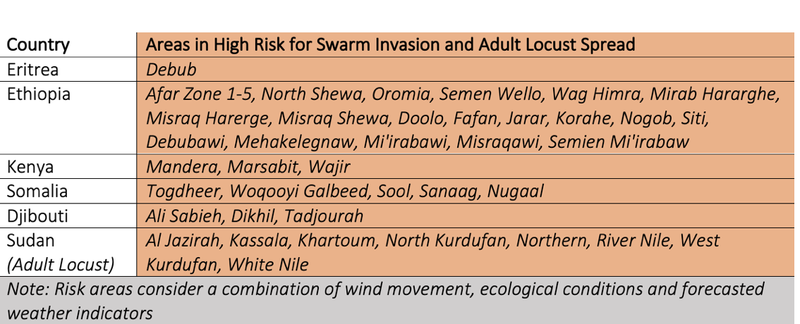Risk of significant impact to both crops and rangelands is high in Ethiopia and Somalia
Desert Locust Movement Prediction November 2021

Locations with reported swarms and adult locusts
- Ethiopia: between October and early November, the desert locust swarms were reported mostly in Afar zone 1. Recently swarms have been reported in Somali region of Ethiopia.
- Somalia: swarms reported have been in most of the persistent breeding areas that include Awdal, Togdheer, Woqooyi Galbeed, Sool and Sanaag regions in north and the north-eastern Somalia.
- Kenya: one swarm was recently reported in Mandera north-eastern region of the country.
- Sudan: adult locusts have been reported mostly in Northern, River Nile, Kassala and North Kurdufan regions showing breeding and reproduction activities. From Sudan Locust Control mid-October assessment, Desert Locust (DL) situation is at the caution level, particularly in the River Nile State. Limited control operations conducted against congregant breeding and mature/ immature groups, hopper bands and groups from 1st – 5th instars stages, and fledglings in some locations at the River Nile Valley near Karima and east of Shendi. Good rains changed the habitat making it favourable for DL in most of the summer breeding areas.
Desert locusts movement projection November 2021
Forecasted climatic and ecological conditions
- Conditions that favour swarms to migrate in search of areas to lay eggs and moist sandy soils have low suitability in the north of the region. Winter breeding is expected to start in Red-Sea areas of Eritrea.
- The heavy rainfall received in eastern Ethiopia and northern Somalia increases the likelihood of having abundant vegetation to sustain hatched locust to significant numbers of adult locust, bands and hoppers reported. Swarms have been reported to be migrating south-wards with the winds to Somali regions of Ethiopia, central Somalia and one swarm reported in north-eastern Kenya.
- Ecological conditions (particularly the availability of green vegetation) continue to be suitable in parts of the northern sub-region due the current above average rainfall which may continue into November before vegetation starts to dry-off in December.
- Wind direction and speeds, which highly determine swarm movement, are forecasted to be south-westerly which is likely to favour north-east and north-west locust movement for the mature swarms. In Ethiopia the northern wind direction is forecasted to favour north-west locust swarm movement to Eritrea.
- Intermittent multi-directional winds and local topography may favour swarms to move in varying directions during the projection period.
Areas of highest risk November 2021
Highest risk areas for desert locust swarm invasion and adult locust development based on forecasted climate conditions and existing vegetation conditions are outlined below:

Expected impacts on crops and rangelands
- Somalia: is currently in planting stages for the Deyr maize and sorghumcrop and face a high-risk of impacting crop production due to increasing locust swarms in Awdal, Togdheer, Woqooyi Galbeed, Sool and Sanaag. Changing winds are enabling migration to central regions which are the areas with significant crop production. The impacts on rangelands is predicted to be moderate-risk due to lower swarm numbers which may not significantly reduce forage availability.
- Ethiopia: the south Somali region where planting of main season sorghum and teff crops is underway with the crops likely to have a high-risk of impacting crop production. For the Meher crop season in Ethiopia which are at harvest stage face a moderate-risk of impacting crop production. The impacts on rangelands is predicted to be moderate-risk due to lower swarm numbers which may not significantly reduce forage availability.
- Sudan: the main season crops millet and sorghum are in vegetative to reproductive stage which means with increasing adult locust, a moderateimpact on crop production is predicted in North Kurdufan, Kassala and Al Jazirah.
